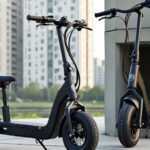Understanding Ebike Injury Statistics
Ebike Injury Statistics reveal a growing concern in public health. In recent years, injuries from ebike accidents have significantly increased, highlighting the need for awareness and preventive measures.
To quickly grasp the situation:
- Ebike injuries rose 18.6-fold from 2018 to 2023.
- Nearly 10% of ebike accident victims in California require hospitalization.
- Riders are more likely to suffer severe injuries, such as pelvic fractures and head trauma.
The rapid rise in ebike usage, especially among younger riders and in affluent areas, has brought new challenges. Common issues include unsafe speeds, battery fires, and improper turns, making safety more critical than ever.
Ebike-related injuries are becoming a major public health concern, with head trauma and severe internal injuries being more common among ebike riders compared to traditional cyclists. This trend underscores the importance of better regulations, education, and safety measures to protect riders and those around them.

Basic Ebike Injury Statistics terms:
The Surge in Ebike Injuries
Electric bikes (ebikes) are becoming more popular, but this rise in popularity has come with a significant increase in injuries. Let’s break down the alarming trends and the most common types of ebike injuries.
Annual Increase in Injuries
From 2017 to 2022, ebike injuries in the U.S. skyrocketed. According to the research:
- Ebike injuries increased by 30 times.
- Hospitalizations rose by 43 times.
This means that not only are more people getting hurt, but the injuries are severe enough to require hospital stays. In fact, more than 45,000 emergency room visits and over 5,000 hospitalizations were recorded due to ebike accidents during this period.

Common Types of Injuries
Ebike accidents can cause various injuries, but some are more common than others. The most frequently reported injuries include:
- Upper and Lower Extremities: Broken wrists, legs, and other limb injuries are prevalent. These usually happen when riders fall or collide with obstacles.
- Head Injuries: Cuts, concussions, and traumatic brain injuries are alarmingly common. The decline in helmet usage only exacerbates this problem.
- Blunt Injuries: These occur when riders hit hard surfaces like car doors or the ground. Such injuries can be severe and often lead to hospital visits.
Dr. Adrian Fernandez, the lead author of the study published in JAMA Surgery, highlighted the explosive trend of increasing injuries and hospitalizations. He noted that head injuries among ebike riders are particularly concerning due to the declining use of helmets.
“We saw a really explosive trend of increasing injuries and hospitalizations,” Fernandez said. “The increasing proportion of head injuries in our study warrants further examination, as traumatic brain injuries are more severe in e-bicyclists than in traditional bicyclists.”
Understanding these statistics and injury types is crucial for improving safety measures and reducing the risk of accidents. It’s essential to address these issues through better regulations, public awareness, and safety practices.
Next, we will dig into the specifics of head injuries and helmet usage among ebike riders.
Head Injuries and Helmet Usage
Decline in Helmet Usage
Helmet use among ebike riders has been on a steady decline. Research shows that helmet usage fell by almost 6% each year from 2017 to 2022. This is concerning because helmets are a crucial safety measure.
In 2022, only 44% of injured ebike riders were wearing helmets. This decline in helmet use is a significant public health problem. Without helmets, riders are much more vulnerable to head injuries.
Severity of Head Injuries
Head injuries are among the most severe consequences of ebike accidents. Helmetless riders are nearly twice as likely to suffer head injuries compared to those who wear helmets.
Common head injuries include:
- Concussions: These are common in falls and collisions. They can cause headaches, dizziness, and long-term cognitive issues.
- Skull Fractures: These are more severe and can lead to permanent damage or even death.
- Traumatic Brain Injuries (TBIs): These are the most severe head injuries. TBIs can result in long-term disabilities, impacting memory, motor skills, and overall brain function.
Dr. Benjamin Breyer, chair and professor of urology at UCSF, emphasized the severity of these injuries.
“I’d love to see more people wearing helmets. As a society, cities and towns can produce real changes on the road that impact safety and prevent these kinds of injuries,” Breyer said.
The rise in traumatic brain injuries among ebike riders is particularly alarming. These injuries are often more severe than those sustained by pedal-powered bicyclists. The increased speed of ebikes, which can reach up to 28 miles per hour, makes accidents more dangerous.
Dr. Laura Goodman, a pediatric surgeon and trauma medical director, has seen a surge in ebike injuries among children.
“E-bikes are dangerous. It requires a lot of education to ride them, and we’re letting kids go out and ride them as if they’re traditional bikes, and they’re not,” Goodman said.
Understanding the dangers and the importance of helmet use can help reduce these severe injuries. Next, we will explore the demographics and injury patterns among ebike riders.
Demographics and Injury Patterns
Age and Injury Rates
Ebike injury statistics reveal distinct patterns when it comes to age. Two primary age groups are particularly affected: children under 14 and older adults.
Children under 14 are especially vulnerable. They account for 36% of micromobility injuries, even though they make up only 18% of the U.S. population. This disparity highlights a significant risk for younger riders. Dr. Laura Goodman, a pediatric surgeon, explained:
“E-bikes are dangerous. It requires a lot of education to ride them, and we’re letting kids go out and ride them as if they’re traditional bikes, and they’re not.”
Older adults also face unique risks. Ebike riders are often nearly a decade older than traditional cyclists. This age group is more likely to suffer severe injuries requiring hospital admission. The increased speed and weight of ebikes contribute to this higher risk.
Older adults tend to have slower reaction times and are more prone to serious injuries. These injuries often require longer hospital stays and more surgeries.
Racial Disparities in Injuries
There are also significant racial disparities in ebike injuries. Non-Hispanic Black consumers are disproportionately affected. They represent 29% of micromobility device-related injuries, despite being only 13% of the U.S. population.
This higher injury rate among non-Hispanic Black riders raises questions about systemic issues and disparities in healthcare access and quality. According to a UCSF study, the reasons for this disparity are not entirely clear, but they align with broader concerns about healthcare inequities.
Understanding these demographic patterns is crucial for addressing the risks associated with ebike usage. By focusing on vulnerable age groups and addressing racial disparities, we can develop targeted safety measures to reduce injuries.
Next, we’ll look at how seasonal and environmental factors impact ebike injuries.
Seasonal and Environmental Factors
Seasonal Trends
Ebike injury statistics show a clear pattern when it comes to seasons. Injuries peak from May to October, which are the warmer months when more people are out riding. During this time, emergency departments see the highest rates of ebike-related injuries.
In contrast, the colder months, December and January, have fewer injuries. This trend is likely due to fewer people riding in the winter. However, note that riding conditions can be more hazardous in winter due to ice, snow, and reduced daylight.
Urban vs. Rural Risks
The environment where you ride an ebike also plays a significant role in injury risk. Urban areas tend to have higher rates of ebike injuries due to the dense traffic and the need for better infrastructure. City commuting often involves navigating through busy streets, which increases the risk of accidents.
In cities like New York, the rise in ebike deliveries has led to more accidents. The New York City Department of Transportation reported that bicycle deaths reached a 24-year high in 2023, with 23 out of 30 fatalities involving ebikes.
On the other hand, rural riding presents different challenges. While there might be less traffic, the roads can be poorly maintained, leading to accidents due to potholes or uneven surfaces. Lack of dedicated bike lanes also increases the risk for rural riders.
Infrastructure challenges are a common issue across both environments. Whether in urban or rural areas, the absence of proper bike lanes and docking stations heightens the risk. Improving infrastructure is crucial for reducing these risks.
Understanding these seasonal and environmental factors helps in planning safer ebike rides. Next, we’ll discuss the fire hazards associated with ebikes and how to mitigate them.
Fire Hazards and Safety Measures
Battery-Related Incidents
Ebike injury statistics reveal that battery fires are a significant hazard. The U.S. Consumer Product Safety Commission (CPSC) reported 19 deaths tied to micromobility device fires from January 2021 to November 2022. These fires are often linked to lithium-ion batteries, which power most ebikes.
Lithium-ion batteries can be dangerous if not handled correctly. When they malfunction, they can overheat, catch fire, or even explode. This can happen due to poor manufacturing, damage, or improper charging.
Safety Recommendations
To help prevent battery fires and ensure safety, follow these tips:
-
Use Approved Batteries: Always use batteries and chargers that meet safety standards. Avoid using modified or re-purposed battery packs.
-
Proper Charging: Charge your ebike in a well-ventilated area. Never charge it while you’re asleep or away. Follow the manufacturer’s instructions for charging and unplug the device once it’s fully charged.
-
Inspect Regularly: Before each ride, check your ebike for any signs of damage, especially the battery. Look for cracks, swelling, or leaks.
-
Manufacturer Instructions: Stick to the guidelines provided by the manufacturer. They know their product best and will provide the safest way to use it.
-
Disposal of Batteries: Never throw lithium batteries in the trash. Take them to a local battery recycler or hazardous waste collection center.
By following these safety recommendations, you can significantly reduce the risk of battery fires and enjoy a safer ebike experience.
Next, let’s explore the broader preventive measures and safety tips that can help make ebike riding safer for everyone.
Preventative Measures and Safety Tips
Helmet Laws and Enforcement
Helmet laws are critical in reducing severe head injuries among ebike riders. Unfortunately, helmet usage among ebike riders has been declining by about 6% annually. This is alarming, given the increasing number of head injuries.
Mandatory Helmet Use: Some states require helmets for all ebike riders, while others only mandate them for minors. In states like California, helmets are required for riders under 18. However, enforcement is inconsistent, making it a challenge to ensure compliance.
State Regulations: States like New York and Florida are considering stricter regulations, including licensure and insurance requirements. These measures could help enforce helmet laws more effectively.
Enforcement Challenges: One of the biggest problems is the lack of uniformity in helmet laws across states and cities. This creates confusion and non-compliance among riders. Improved public education and stricter enforcement could help bridge this gap.
Urban Design and Infrastructure
Urban design plays a crucial role in ensuring the safety of ebike riders. Proper infrastructure can significantly reduce the risk of accidents.
Bike Lanes: Dedicated bike lanes are essential. They provide a safe space for ebike riders, separate from motor vehicles. Cities like San Francisco and New York have been expanding their bike lane networks, but more is needed.
Traffic Safety: Improved traffic signals and signage can improve safety. For example, dedicated bike traffic lights can help manage ebike traffic more efficiently.
City Planning: Urban planners need to consider the growing popularity of ebikes. Incorporating ebike-friendly routes and docking stations can make commuting safer and more convenient.
Rider Education and Training
Educating riders is one of the most effective ways to reduce accidents and injuries.
Safety Courses: Offering safety courses can teach riders the basics of ebike operation, traffic rules, and emergency maneuvers. These courses can be organized by local governments or community organizations.
Parental Guidance: Parents should educate their children about the importance of wearing helmets and following traffic rules. Given the rise in injuries among younger riders, this is crucial.
Community Programs: Community-led initiatives can promote safe riding practices. Programs like helmet giveaways, safety workshops, and group rides can foster a culture of safety among ebike riders.
By focusing on these preventative measures and safety tips, we can create a safer environment for all ebike riders. Next, let’s move on to frequently asked questions about ebike injury statistics.
Frequently Asked Questions about Ebike Injury Statistics
What are the most common types of ebike injuries?
Ebike injuries often involve the upper and lower extremities, followed by head injuries. According to a 2023 report by the Consumer Product Safety Commission, fractures and contusions are the most frequent injuries. Commonly affected areas include:
- Upper extremities: Broken wrists and arms.
- Lower extremities: Broken legs and ankles.
- Head injuries: Concussions and scalp lacerations.
Blunt injuries, such as those from hitting a car door or falling on hard ground, are also prevalent.
How can ebike riders reduce the risk of head injuries?
Reducing the risk of head injuries is crucial for ebike safety. Here are some effective measures:
-
Wear a Helmet: Despite the decline in helmet usage, wearing a helmet can significantly reduce the risk of head trauma. Helmets with MIPS (Multi-directional Impact Protection System) certification offer added protection against concussions.
-
Follow Traffic Rules: Obeying traffic signals, riding in designated bike lanes, and avoiding reckless behaviors like speeding can prevent accidents.
-
Improve Visibility: Use lights and reflective gear, especially at night or in low-visibility conditions. This helps motorists see you, reducing the risk of collisions.
Are there specific safety standards for ebike batteries?
Yes, ebike batteries, particularly lithium-ion ones, must meet certain safety standards to prevent fire hazards. Here are key points to consider:
-
Proper Charging: Always use the charger provided by the manufacturer and avoid overcharging the battery.
-
Approved Batteries: Use batteries that meet safety certifications and standards. Avoid cheap, uncertified batteries as they pose higher risks.
-
Manufacturer Instructions: Follow the manufacturer’s guidelines for battery maintenance and storage. This includes keeping the battery away from extreme temperatures and moisture.
By adhering to these safety standards, riders can minimize the risk of battery-related incidents.
Next, we’ll dig into the conclusion, discussing the importance of public awareness and safety improvements in the ebike industry.
Conclusion
Ebike injuries are a growing public health concern. As we’ve seen, the rise in injury rates, especially head injuries and battery fires, calls for urgent action. Public awareness and safety improvements can significantly reduce these risks.
Doot Scoot is committed to promoting safe and responsible ebike riding. By providing comprehensive reviews, in-depth guides, and expert comparisons, we aim to help riders make informed decisions. Our focus on eco-friendly and urban mobility solutions positions us as a leader in the ebike community.
Public Awareness
Increasing public awareness about ebike safety is crucial. Riders need to understand the importance of wearing helmets, following traffic rules, and using certified batteries. Education campaigns can highlight these safety measures, reducing the likelihood of accidents.
Safety Improvements
Policymakers and urban planners also have a role to play. Implementing helmet mandates, improving urban infrastructure with dedicated bike lanes, and enforcing battery safety standards can make a significant difference. Cities like New York and San Diego are already seeing the benefits of such measures.
Call to Action
At Doot Scoot, we believe in the power of community and education. We encourage you to explore our best ebike deals and take advantage of our resources to ride safely and responsibly. Together, we can make ebiking a safer and more enjoyable experience for everyone.
By staying informed and advocating for better safety measures, we can reduce ebike injuries and make our streets safer for all.











